Like many kids growing up, I loved comics. Between Christmas Beano and Dandy annuals, Marvel comics gifted weekly by a kind uncle and my trips to the library for Asterix and Tintin books I was, and still am, a big fan of the sequential art form. But it was Hergé’s Tintin books that I enjoyed the most, with those clear line style illustrations and adventures in foreign lands.
Hergé was a perfectionist, and when it came to accuracy in his depiction of locations and vehicles, his dedication was faultless. But I always felt that he did not seem to apply the same robust research to his wildlife illustrations, particularly his birds. I also felt that many scenes just seemed to lack birds when they should have been there; Tintin visits dozens of cities and doesn’t encounter a single feral pigeon, for example. Maybe Hergé just didn’t want to clutter up his wonderful panels with unnecessary distractions? But birds do sometimes feature in the books, so I automatically assumed that someone at some time or other would have explored this subject in detail. However, after trawling the internet I came up with nothing. Surely, just like the plucky reporter before me, I was just the man for the job!?
This had been in the back of my mind for a long time, but it took a period of self isolation with Covid to spur me into action. I had the time after all. So I piled my books beside by bed and set to work. And, now dear reader, I am ready to report my findings, as follows:
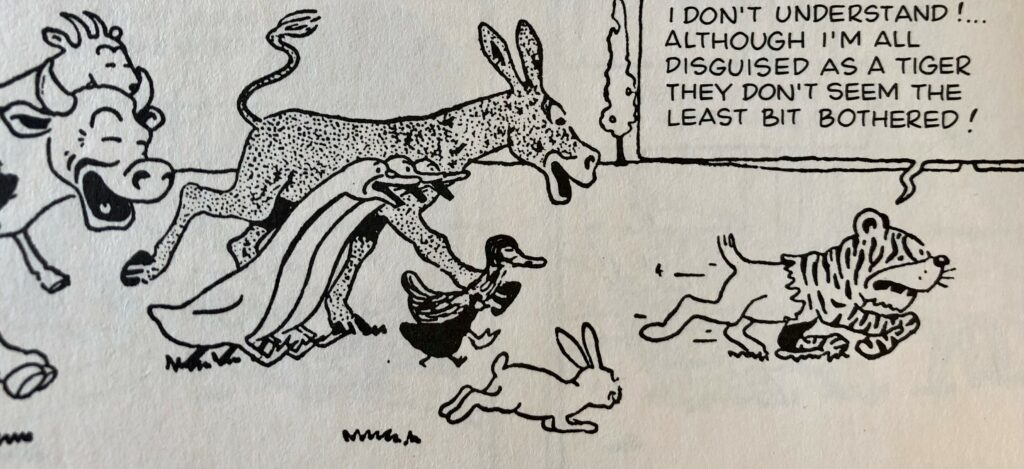 Tintin in the Land of the Soviets was Tintin’s first adventure, published serially in 1929 in Le Petit Vingtième, a children’s supplement to a Belgian daily newspaper. On page 124 of my reproduction edition Hergé depicts his first birds in a Tintin book; three white domestic geese. These are joined on the next page by a scruffy looking duck and a cute chicken (who immediately vanishes in the next panel, as it presumably can’t keep up with the chase). The geese appear in 7 panels, the duck in two and the in hen one, so in the whole book Hergé draws a bird 24 times; all domestic, none wild (24D 0W).
Tintin in the Land of the Soviets was Tintin’s first adventure, published serially in 1929 in Le Petit Vingtième, a children’s supplement to a Belgian daily newspaper. On page 124 of my reproduction edition Hergé depicts his first birds in a Tintin book; three white domestic geese. These are joined on the next page by a scruffy looking duck and a cute chicken (who immediately vanishes in the next panel, as it presumably can’t keep up with the chase). The geese appear in 7 panels, the duck in two and the in hen one, so in the whole book Hergé draws a bird 24 times; all domestic, none wild (24D 0W).
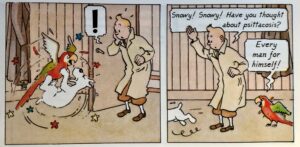 Tintin in the Congo, probably the author’s most controversial work, is the only story to mention bird-related disease! On passage to the Congo Snowy gets into a scrape with the ships’ red and green parrot (the first of several depictions of macaws throughout the series of books), and is bitten on the tail. Tintin exclaims “Snowy! Snowy! Have you thought about psittacosis?” which strikes me as unusual, as Tintin should know that heath and safety are way down Snowy’s list of priorities (food, whisky and fighting being much more important to him). The macaw’s two-tone plumage prevent an accurate pinpointing of species, but an aberrant Scarlet Macaw is most likely.
Tintin in the Congo, probably the author’s most controversial work, is the only story to mention bird-related disease! On passage to the Congo Snowy gets into a scrape with the ships’ red and green parrot (the first of several depictions of macaws throughout the series of books), and is bitten on the tail. Tintin exclaims “Snowy! Snowy! Have you thought about psittacosis?” which strikes me as unusual, as Tintin should know that heath and safety are way down Snowy’s list of priorities (food, whisky and fighting being much more important to him). The macaw’s two-tone plumage prevent an accurate pinpointing of species, but an aberrant Scarlet Macaw is most likely.
The only other bird in the book (which is probably fortunate due to Tintin’s blood lust throughout the adventure) is on the last panel of the final page and it is a solitary (presumably Greater) Flamingo, weeping at our hero’s departure. I have two editions of this book: a facsimile black and white book of the original newspaper story from 1930 and the re-drawn colour version from 1946 (published in 2005). In the first, Hergé draws the macaw in 12 panels (one in a fight with Snowy in which it’s head appears three times!) , but in the colour version it appears 13 times. (13D 1W)
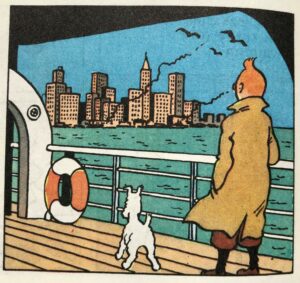 Tintin travels across the Atlantic Ocean for Tintin In America, and the book has birds in only two panels. Three domestic geese fleeing a fire on page 38 and three gulls in silhouette as Tintin looks back to the mainland from the deck of his ship on page 62. This is the first of many such depiction of gulls, the classical childlike broad ‘M’s in the sky, and any attempts to pinpoint specific species would be purely speculation on my part, based on location only. But that’s what I’m here for, so based on location (East Coast USA) and behaviour (following a boat) I’m sticking my neck out and saying these are American Herring Gulls. (3D 3W)
Tintin travels across the Atlantic Ocean for Tintin In America, and the book has birds in only two panels. Three domestic geese fleeing a fire on page 38 and three gulls in silhouette as Tintin looks back to the mainland from the deck of his ship on page 62. This is the first of many such depiction of gulls, the classical childlike broad ‘M’s in the sky, and any attempts to pinpoint specific species would be purely speculation on my part, based on location only. But that’s what I’m here for, so based on location (East Coast USA) and behaviour (following a boat) I’m sticking my neck out and saying these are American Herring Gulls. (3D 3W)
Chronologically, Cigars of the Pharoah comes next and despite depicting plenty of panels of our heroes on the deck of a boat, no seabirds are to be seen. In fact only one bird appears at all, a caged macaw that Tintin buys along with a load of other “useless junk” from travelling Portuguese merchant, Oliveira da Figueira. The splash of yellow on the wing of this bird make another Scarlet Macaw most likely, and slightly more accurately depicted than the one in Congo, but the lack of blue still makes a definite species identification harder. (D1 W0)
Gulls are the next bird to feature , showing up on page 14 of The Blue Lotus. Three birds in silhouette over the ship (the Ranchi) as Tintin sets sail for Bombay from Shanghai. Again, a Herring Gull species seems likely but, as Hergé typically avoids dates in his stories, time of year cannot be used to help hazard a guess at the most likely based on breeding range. They will definitely be a different species to the herring gulls in America, so lets lump these as Vega/East Siberian Herring Gulls and crack on. On page 48 a white pigeon or dove is used by the baddies to send messages, with the same bird appearing in five panels. The book has several depictions of birds as Chinese art, on vases and paintings and the like, but I’m not counting those, as that would be ridiculous. (D5 W3)
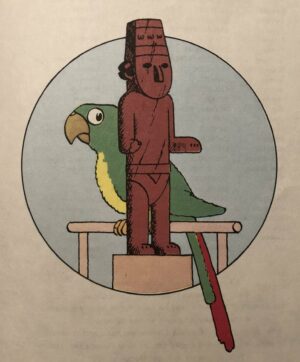 The Broken Ear is the first book to feature a bird as part of the plotline, when a talking pet parrot witnesses a murder. The parrot, named Polly by Tintin, is green with a yellow belly and long red-tail, the closest species being a Jamaican Green-and-yellow Macaw. Despite being randomly abusive to the larger gent, Polly turns out useful when fingering (primary-feathering?) the murderer. Hergé draws the bird in eighteen panels and on the books’ title page, nineteen times in total. (D19 W0)
The Broken Ear is the first book to feature a bird as part of the plotline, when a talking pet parrot witnesses a murder. The parrot, named Polly by Tintin, is green with a yellow belly and long red-tail, the closest species being a Jamaican Green-and-yellow Macaw. Despite being randomly abusive to the larger gent, Polly turns out useful when fingering (primary-feathering?) the murderer. Hergé draws the bird in eighteen panels and on the books’ title page, nineteen times in total. (D19 W0)
Next we come to The Black Island, often referred to as a turning point for Hergé in terms of maturity in his work. In this story Tintin travels to Scotland, and Hergé goes bird crazy! The Black Island of the title is a castle on a rock, surrounded by birds in silhouette around it’s towers for extra menace, pre-dating Hitchcock’s The Birds by seven years. Before we get to these avian harbingers of peril though, Snowy chats to three domestic geese on one panel in page 5 ; we are not privy to their discussion, but I like to think they are catching up after their adventures in Russia and America.
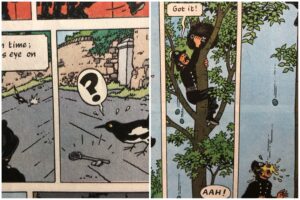 There is also a slapstick moment (pages 19-20) when the local fire service lose the key to the station and it is stolen by a Eurasian Magpie (with a bizarre white tail band) which features in four panels before the key is found and Tintin is rescued. On retrieving the key from the bird’s nest, a hapless Thomsonesque fireman disrupts the eggs, which topple out and break on his colleagues’ heads below. The eggs are pale blue with black speckles-exactly like those of the Eurasian Magpie. It seems Hergé had done his homework here and confirms the species, aberrant tail band and all.
There is also a slapstick moment (pages 19-20) when the local fire service lose the key to the station and it is stolen by a Eurasian Magpie (with a bizarre white tail band) which features in four panels before the key is found and Tintin is rescued. On retrieving the key from the bird’s nest, a hapless Thomsonesque fireman disrupts the eggs, which topple out and break on his colleagues’ heads below. The eggs are pale blue with black speckles-exactly like those of the Eurasian Magpie. It seems Hergé had done his homework here and confirms the species, aberrant tail band and all.
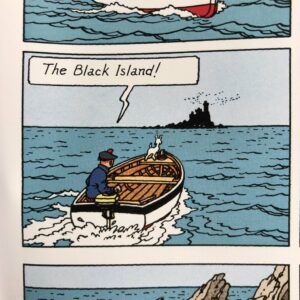 Later, as Tintin and Snowy approach the Black Island by boat on page 43, the birds can be seen, forebodingly circling the tower of the castle. There are various possibilities for these birds, based on geography and habitat. The magpie on page 20 proves this is nesting season, so these birds are likely to be nesting on the steep cliffs beneath the castle, narrowing down the species possibilities. The fact that they are circling high around the castle would exclude auks such as Puffins, Guillemots and Razorbills, and favour cliff nesting Kittiwakes and Fulmars, and also several gull species such as European Herring Gull and Lesser Black-backed Gull. However, Gannets, breed in in large numbers in colonies on similar islands on the west coast of Scotland, such as Ailsa Craig and Sanda Island off the Mull of Kintyre. Looking at the cover I am certain Gannets are featured here, but surely some of those aforementioned species must also be in the mix closer to the island? There are 323 of them across various pages and panels, so I’d expect a few each of those species to be present, and I am going to include them on my final list. Bite me. (D3 W327)
Later, as Tintin and Snowy approach the Black Island by boat on page 43, the birds can be seen, forebodingly circling the tower of the castle. There are various possibilities for these birds, based on geography and habitat. The magpie on page 20 proves this is nesting season, so these birds are likely to be nesting on the steep cliffs beneath the castle, narrowing down the species possibilities. The fact that they are circling high around the castle would exclude auks such as Puffins, Guillemots and Razorbills, and favour cliff nesting Kittiwakes and Fulmars, and also several gull species such as European Herring Gull and Lesser Black-backed Gull. However, Gannets, breed in in large numbers in colonies on similar islands on the west coast of Scotland, such as Ailsa Craig and Sanda Island off the Mull of Kintyre. Looking at the cover I am certain Gannets are featured here, but surely some of those aforementioned species must also be in the mix closer to the island? There are 323 of them across various pages and panels, so I’d expect a few each of those species to be present, and I am going to include them on my final list. Bite me. (D3 W327)
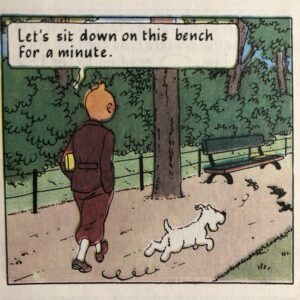 Tintin’s seventh adventure is King Ottokar’s Sceptre. It is very light on birds, with only two panels of avian interest; the second panel on page 1 when Snowy chases three small black birds down a park path, and a cockerel wake-up call on page 58. The birds in the park look more like a petrel and two miniature corvids, but in all likelihood they are Blackbirds or Starlings, and I’m going with the latter in light of the fact they appear to be grouped together. (D1 W3)
Tintin’s seventh adventure is King Ottokar’s Sceptre. It is very light on birds, with only two panels of avian interest; the second panel on page 1 when Snowy chases three small black birds down a park path, and a cockerel wake-up call on page 58. The birds in the park look more like a petrel and two miniature corvids, but in all likelihood they are Blackbirds or Starlings, and I’m going with the latter in light of the fact they appear to be grouped together. (D1 W3)
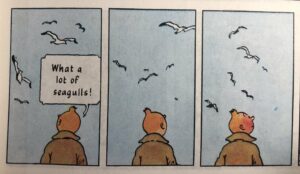 The Crab With The Golden Claws is famous for being the first book that features Captain Haddock, but it is the only book in the series where Tintin can be seen actually birdwatching!
The Crab With The Golden Claws is famous for being the first book that features Captain Haddock, but it is the only book in the series where Tintin can be seen actually birdwatching!
On page 9 he rushes to the Belgian docks and there are several panels of him noticing the gulls. “What a lot of seagulls” he comments, before almost being killed by a falling crate. These gulls are all white, rather than just black silhouettes and feature in seven panels. Across these panels, Hergé draws thirty six of these birds and it’s tempting to assume a mixture of Black-headed Gull, Herring Gull, and Lesser Black-blacked Gull, but really, they are definitely all white. Now, its unlikely that Tintin has stumbled upon a lost flock of Iceland or Ivory Gulls, so these are clearly just as Tintin says “seagulls”, which any birder will tell you do not exist. So, I am calling these Hergé’s Gulls and that’s the end of it. (D0 W36)
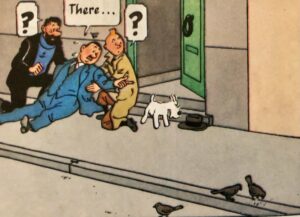 The Shooting Star is the first of five books with no birds in it at all. Which is as opportunity missed as Tintin travels by boat towards the arctic, so Ivory Gull or Gyrfalcon could have reasonably cropped up! (D0 W0)
The Shooting Star is the first of five books with no birds in it at all. Which is as opportunity missed as Tintin travels by boat towards the arctic, so Ivory Gull or Gyrfalcon could have reasonably cropped up! (D0 W0)
Birds make a very brief, but important appearance in Hergé ‘s next book, The Secret of The Unicorn. At the bottom of page 31, as he lies dying from drive-by gunshot wounds in Tintin and Haddock’s arms, a man points to three birds, that Tintin confirms as “sparrows”. The man then promptly dies. Two breeds of sparrow occur in Belgium, but these, jauntily feeding on a kerb-side, can be only House Sparrows. The man, unable to speak is trying to give a clue to his assassin a Mr Max Bird. (D0 W3)
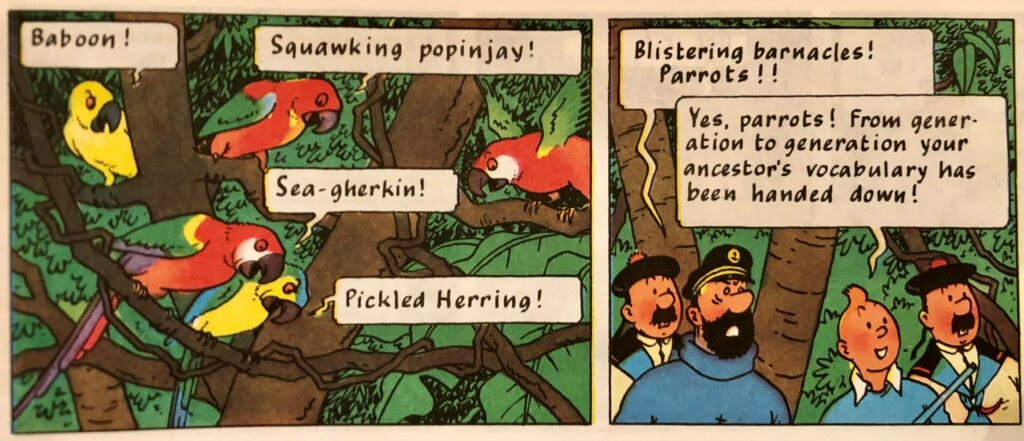 Red Rackham’s Treasure is the second instalment of the pirate story started in Unicorn, and features more fish than birds. On an island previously inhabited by Haddocks’ ancestor, Sir Francis Haddock and the Unicorn’s crew, our heroes are abused by five macaws from above. “Baboon! Squawking popinjay! Sea-Gherkin! Pickled Herring!” they cry as Haddock gets more and more irate. The birds appear to be three Scarlet Macaws (clear plumage detail improvements from Hergé here, making them unmistakable this time) and two Blue-and-yellow Mackaws, all descended from Sir Francis’ original ship’s parrots. These will now be wild birds, the only depiction of wild macaws throughout the series. All in all, Hergé draws seven of these across three panels in the book. (D0 W7)
Red Rackham’s Treasure is the second instalment of the pirate story started in Unicorn, and features more fish than birds. On an island previously inhabited by Haddocks’ ancestor, Sir Francis Haddock and the Unicorn’s crew, our heroes are abused by five macaws from above. “Baboon! Squawking popinjay! Sea-Gherkin! Pickled Herring!” they cry as Haddock gets more and more irate. The birds appear to be three Scarlet Macaws (clear plumage detail improvements from Hergé here, making them unmistakable this time) and two Blue-and-yellow Mackaws, all descended from Sir Francis’ original ship’s parrots. These will now be wild birds, the only depiction of wild macaws throughout the series. All in all, Hergé draws seven of these across three panels in the book. (D0 W7)
I don’t think even the most die-hard Tintin fan slash ornithologist can take much more of this in one sitting so I’ll stop now, with another 12 books yet to come! What a cliff-hanger, eh?! Tune in for Part 2 coming soon!

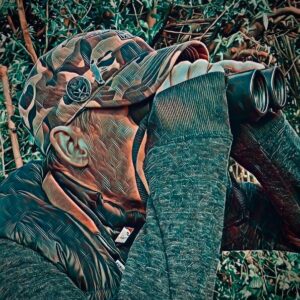
3 Responses
I think that PhD is calling, if you can find the right Academic Institution 👍. Very engaging writing, by the way.
Thank you!